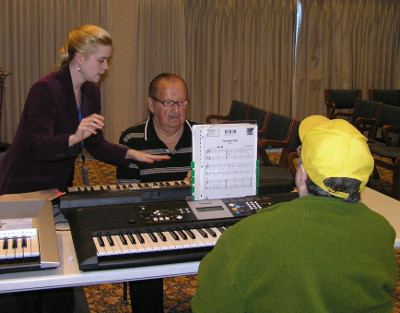Rebecca Sorley (University of Indianapolis), piano
MacLaren Youth Correctional Facility, Oregon State Youth Authority, Woodburn, Oregon
October 22, 2009
The 16 participants, aged 14 – 19, were special needs juvenile offenders who lived in a group home inside the facility. The young men were diagnosed with a variety of special needs including autism, mental handicaps, schizophrenia, and bi-polar disorder.
The group was accompanied by two armed guards and four adults. Participants were carefully chosen for this project by the facility staff.
This project introduced the participants to the music of Mozart and encouraged them to work together in order to create small performance pieces based on the composer. The young men were well prepared for the event having completed some preliminary study of the piano and Mozart before the event. Ms. Sorley performed selected piano solos by Mozart and discussed biographical details of his life. The presentation also included a recording of
Eine Kleine Nachtmusik, mvt. 1. The students then split into three groups: one wrote a text to the first few notes of Sonata in C Major, K.545, mvt. 1
, another group wrote a short rap related to the biographical information presented at the beginning of the program, the final group completed an arrangement of the opening rhythm of Eine Kleine Nachtmusik
, mvt. 1 using small rhythm instruments. Each group was supervised and assisted by individual staff members and the young men were instructed to make sure that all helped in the process of forming a composition. They worked well together and were constructively involved. The groups presented their compositions in performance for one another and were extremely attentive and polite. One young man expressed that he liked listening to Mozart because it helped him calm down and made him happy. Another had done some research and asked Ms. Sorley if she knew that the piano was invented in 1720. This project proved to be a rewarding experience for not only the participants, but also the presenter.
Christina M. Hornbach (Hope College), Holland, Michigan
Peninsula Children's Center, Portland, Oregon
Saturday, October 24, 2009
The participants of this workshop
were early childhood teachers, with limited musical background, from the Peninsula Children's Center. The Peninsula Children’s Center is an early childhood care and education program that serves children, ages 6 weeks through 5, from diverse socio-economic
backgrounds.
The goal of this activity-based early childhood music workshop was to provide classroom teachers with specific activities for developing the musical skills of young children. It sought to stimulate and encourage teachers to incorporate more music into their lesson plans. Through movement, singing, chanting, and play, the classroom teachers learned methods for introducing students to an extensive musical vocabulary. The workshop was well received, and the participants were enthusiastic in their participation.
Daniel C. Johnson, University of North Carolina, Wilmington
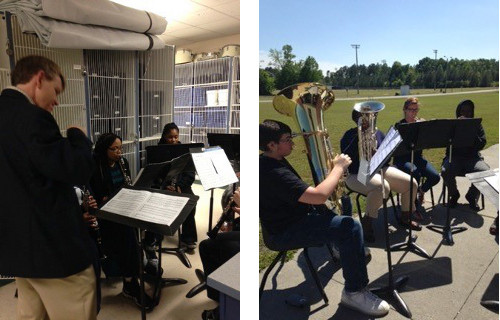
With the support of a Seed Grant from The CMS Fund, I conducted an action research project to investigate the effect of chamber music participation
on student learning in terms of twenty-first century skills. Sometimes referred to as the Four Cs, those skills are: critical thinking, collaboration, communication, and creativity. The premise of this project was that students participating in chamber
music ensembles would demonstrate a more developed sense of twenty-first century skills.
With the collaboration of a local high school band director, I organized seventeen students into three ensembles: a saxophone quartet, a clarinet sextet,
and a brass septet. As a pretest, each student completed a questionnaire about the twenty-first century skills. For comparison, students completed a parallel post-test questionnaire. Students from the same band program provided a comparison group and
completed the same pretest and posttest measures.
Preliminary results of the data analysis show that participating in chamber music ensembles benefits student learning. While I complete the data analysis, I thank The CMS Fund its support.
As seed money, this funding allows me to develop a broader investigation into the relationship between music learning and developing twenty-first century skills.
Phoenix Park-Kim (Indiana Wesleyan University), piano
Parker String Quartet, September 18, 2008
American Piano Trio, October 7, 2008
Merwin Siu, violin and Phoenix Park-Kim, piano, April 7 – 8, 2009
Indiana Wesleyan University, Marion, Indiana
This Chamber Music Series was presented to an audience of college students and community members in the community of Marion, Indiana.
The concerts consisted of evening performances and conversations with the performers and were presented in an area where chamber music concerts are rare. Each recital program was carefully selected to demonstrate diverse cultural and ethnic elements and included lesser known composers.
Performers were prepared to discuss the pieces and composers. They also welcomed questions and comments from audience members in between pieces. Through the Chamber Music Series, the audience not only had opportunities to listen to live performances,
but also to engage in conversations with a variety of musicians in a casual atmosphere. Many questions pertained to specific details about repertoire and composers. Other subjects were discussed included how performers got together, how often they
rehearsed, and the cost of their instruments. The project was well received. It resulted in changing the misconceptions that some have about classical musicians. Listeners were able to experience diverse ethnic musical elements within a classical style. Audience members shared that their understanding and appreciation of the music was deepened through the performers' explanations and interactions.
Dena Kay Jones (University of Texas at El Paso), piano
The Radius Cafe, San Antonio, Texas
September 16, 2006
The recital's audience was comprised of cafe patrons and College Music Society members.
The purpose of this recital was to expose audiences to the life and music of Spanish composer Joaquin Rodrigo. The lecture recital was held at the Radius Café: a venue that offers its patrons opportunities to enjoy art, music, movies, and desserts. On-going art exhibits and fresh menu selections provide the backdrop for the café’s meetings, concerts, and banquets.
A lecture recital was presented on the life and select piano works of blind Spanish composer, Joaquín Rodrigo. Approximately 50- 60 cafe patrons and College Music Society members listened and participated in this informal setting. The audience was engaged
in discussion and a question and answer session following the piano performance.
 Tayloe Harding, University of South Carolina
Tayloe Harding, University of South Carolina
David Brian Williams, Illinois State University
Assisted by: Frank Clark (Audio Engineer, Georgia Institute of Technology), Ken Simpson (Director of Music Technology & Jazz, Brookwood High School), Daniel Williams (Saxophone and Flute, Atlanta, Georgia), and Benjamin Diden (Clarinet, Georgia Institute of Technology).
Grassroots 2008 was held at Brookwood High School in Snellville, Georgia. The audience was comprised of approximately 100 students from music, history, and government classes.
September 25, 2008
Grassroots 2008, created by Tayloe Harding and David Brian Williams, was a performance piece that combined composed and improvised music with a slideshow of images pertinent to the 2008 American presidential campaign. Given handheld clickers, the audience voted in response to these images in real-time, and the results were then reflected in the performers' musical improvisations. The performance ensemble consisted of flute, clarinet, saxophone, and two computers. An hour of discussion between students and the composers followed the performance.
Students were discernibly stimulated by the piece's political content. To paraphrase one student’s response, “I never knew my friends thought about the same political issues that concern me.” Subsequent performances of Grassroots 2008 were performed in Atlanta, Georgia and Birmingham, Alabama. Revised Grassroots 2012 performances were presented in Huntsville, Alabama, Richmond, Virginia, Bloomington, Illinois, and Atlanta, Georgia. See the website www.grassroots-2012.net for further information.
Laura Falzon (Teachers College, Columbia University), flute
Max Lifchitz (The University at Albany, SUNY), piano
Georgia State University, Atlanta, Georgia
September 25, 2008
In this presentation flutist Laura Falzon collaborated with pianist Max Lifchitz in a performance of music by composers from Asia, Africa and Latin America for a university class.
The goal of this project was to introduce an audience to lesser known composers and musical styles not normally encountered in traditional recitals. The event followed the format of a lecture-recital. Ms. Falzon and Mr. Lifchitz introduced each piece prior to its performance. At the end of the program, the students asked questions and commented on relevant aspects of the performance. The lecture-recital gave the students the opportunity to listen to and discuss an otherwise obscure repertoire. Audience response was positive, and many expressed interest in learning more about the composers.
Juanita Becker (Wisconsin Lutheran College), piano
Sheri Mattson (University of Central Missouri), oboe
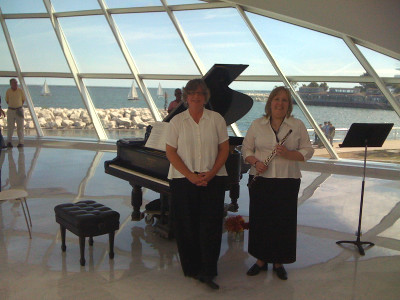
Wisconsin Lutheran College, September 20, 2009
University of Central Missouri, October 19, 2009
Milwaukee Art Museum, December 20, 2009
The audiences for the Milwaukee Art Museum performances were museum patrons and docent volunteers within earshot.
The audiences for performances at Wisconsin Lutheran College and the University of Central Missouri were typical of a college or university. The college presentations were more traditional and included a Power Point presentation of the artwork found in the Milwaukee Art Museum.
The goal of these performances was to introduce participants to the connection that exists between music and visual arts of similar periods. Both performers have actively taught music appreciation courses, and felt that the connection between the visual and musical arts would be an excellent subject for community discourse. Before the performance of each piece, one of the performers spoke about the connection between modern art and music. It was noted that the earliest abstract artists were inspired to create art that was original to them in their attempt to express inner thoughts and feelings. Composers of this time period created music much the same way. The performers indicated that particular artworks in the museum collection could be connected to each piece of music because of its style, the time period of its composition, or because of the friendships between the composers and the artists. For the December event at the Milwaukee Art Museum, programs were handed out with titles of the artwork that paired well with the musical selections.
Linda Pohly (Ball State University), Muncie, Indiana
Elsie Stuhr Center, Center for Senior Activities
Beaverton, Oregon
October 23, 2009
The participants of this project were senior citizens who lived during World War II and the Korean War.
The purpose of this project was to encourage individuals to make connections between music and wartime memories, and to share and document them. Ms. Pohly presented various links that can be found between music and war. She played several excerpts designed
to trigger war memories. The participants were receptive to the variety of music presented, and, after listening, were able to ask questions and share their own memories of music during wartime. Participants were implored to bring written documentation
of their war reminiscences, so that they could be preserved in a booklet. Although only one woman did so, several audience members seemed interested and offered questions and comments. The audience was moved by the woman’s written remarks. They were
affected by her memories of being a small girl in Paris when she heard the “thundering pounding” of Nazi boots marching through the city. The woman explained that that particular memory forever affected her associations with strong musical rhythms.
The participants were receptive to the wide variety of music presented.
Pamela D. Pike (Louisiana State University), piano
Calaroga Terrace Retirement Community, Portland, Oregon
October 24, 2009
The participants were residents of Calaroga Terrace, a retirement community in Portland, Oregon. Some of the participants were able to move about easily on their own, while others required wheelchairs. All were able to sit at portable keyboards to participate in the group-piano music activities.
This project introduced senior citizens to an ensemble keyboard activity. All participants took turns playing together on the keyboards. Participants not playing on a specific piece of music were encouraged to tap, clap, hum, or sing along with those seated at the keyboard. Some participants had experience playing piano and reading music. Others were playing piano for the first time. Due to the choice of ensemble repertoire and through off-staff notational shorthand, the participants were able to make music together during the allotted time.
Novice pianists were introduced to reading a single line of familiar music through non-traditional notation, while more advanced pianists read more complex notation. Each participant was responsible for one part in the overall ensemble piece. The group
rehearsed a piece of music until it was both musically satisfying for the performers and for the other participants in the room. A new group of participants then rehearsed another carefully chosen ensemble piece. Everyone appeared to be engaged and
enjoyed the process of making music while at the keyboards. By using appropriately chosen ensemble repertoire, the senior citizens were able to succeed irrespective of past piano or musical experiences.
Peter Fraser MacDonald and Ria Falkner
Edward Waters College, Jacksonville, Florida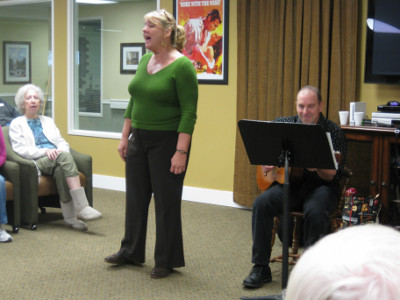
October 27, 2009
This project was held at Regency Park Senior's Facility. Most of the participants were senior citizens experiencing Alzheimer's Disease.
The project engaged senior citizens in the process of music-making through singing and playing simple instruments. Approximately forty-five residents of the facility were gathered into a semi-circle. After a brief introduction, the residents were guided in the performance of a variety of songs. They participated by singing along and playing various percussion instruments provided by the clinicians -- maracas, claves, tambourines, etc. The musical selections were interspersed with discussion of topics related to the chosen theme: Autumn. The Art of Healing was enthusiastically received. Numerous meaningful conversations resulted between staff and residents following the event.
In order to have a successful event of this sort, it is imperative to know the clientele with whom one is engaging. Moreover, the presenters must be able to perform music in various genres and styles and be open to audience participation. A background in music therapy is essential.
Fern Glass Boyd (The University of Montana), cello
Lorraine Glass-Harris (St. Louis Symphony Orchestra), violin
The Berkeley Richmond Jewish Community Center
North Berkeley, California
November 4, 2004
This project sought to provide an informal performance of non-classical music to an audience familiar with Jewish culture. The two
performers presented a 45' program for a varied audience of listeners interested in music by Jewish composers affected by the Holocaust. The informal musical presentation took place on stage with introductory remarks made before each piece was played.
The audience was comprised of all ages: young children, adults, and seniors. Not many school-age children, however, were in attendance, as it was presented during school hours. Audience reaction was positive: Ms. Glass-Boyd related that “they loved the
music!” The musical selections were atypical for a Classical music event. Insofar as the duo was comprised of two sisters, the theme of “family” prevailed throughout the program as well. The audience connected with the performers, appreciating the performance’s
family theme.
Susan Chan (Portland State University), piano
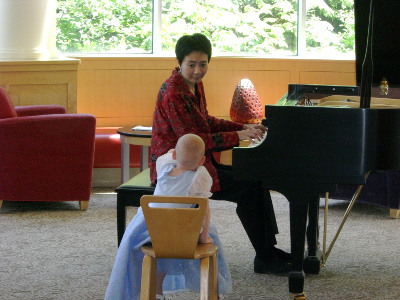
Portland, Oregon
Robison Jewish Home, May 30, 2007
Portland, Oregon
In the first recital, held May 29th, Ms. Chan performed a program of solo piano music that consisted of traditional Western repertoire and contemporary Asian works for young patients, their parents and the hospital staff at Doernbecher's Children's Hospital.
In the second recital on May 30th, Ms. Chan performed a program of solo piano music that consisted of traditional western repertoire and contemporary Asian works for residents and staff of the Robison Jewish Home. This event was different from the May 29th
program in that it was presented as a lecture-recital.
Ms. Chan's goal for this project was to share traditional and contemporary Asian solo piano music with groups of individuals who were either young and hospitalized, or elderly and no longer living independently. She hoped this experience would brighten and enrich their lives. Concert programs were provided prior to the event and, in both cases, audiences were appreciative.
It was obvious that the elderly individuals were very interested in this recital and that some of them were musicians in their younger years. One senior audience member remarked: “thirty minutes of music brings us a day of joy.”
Sophia Serghi (College of William and Mary), Williamsburg, Virginia
Lewis and Clark College, Portland, Oregon
Sponsored by the Columbia Housing Project: Boys & Girls Club of Portland.
October 21-24, 2009
The project involved teenagers, ages 12-18. They were either raised in Inner-city Portland or were teenage immigrants from Togo, recently settled in Portland. All of them had previous experience with Rap which was used to acknowledge their heritage or experiences living in project housing. The teenagers met for three days in a row, for 4-5 hour sessions culminating in a final event which was open to the Lewis and Clark College community and greater Portland.
This project served to introduce teenagers to different styles of Rap Music and to encourage them to use Rap as a creative outlet. Each day the students were given a presentation consisting of the Rap styles they would work to emulate. They worked in a Computer Lab using Software such as, Garage Band to create original instrumental backgrounds. The students’ Rap performances were done either free-style, or prepared with pen and paper. By the last day, each teenager presented up to 6 new original compositions they had created over the three day workshop. Participants were fully engaged in this project, and, as it progressed, they bonded with one another through stories of hardship.
Some friendly competition evolved as they tried to out-perform one another. They were delighted to perform for the public and were heard to say, “They're here just to see us?” “ We're going to perform in front of a real audience?” The performance was
well received which was evident from the quantity and depth of questions that were asked following the presentation.
David Z. Kushner (University of Florida), piano
Ralph Bunche Middle School, Atlanta, Georgia
September 25, 2008
The recital was presented to middle school-aged students from the Ralph Bunche Middle School.
The project's purpose was to introduce middle school children to a wide variety of piano works and composers through a lecture recital. Under their teachers’ instruction, the students prepared for the recital in advance. The repertoire was chosen from a wide variety of composers and styles. Mr. Kushner commented on each piece he performed, and the recital was followed by an exchange of questions and answers. The event was set in an informal, non-threatening environment. As they entered the venue, the students knew what to expect. The students engaged in active listening and their response was positive. Two students' quotes follow: “Chopin was a cool cat.” “Bach was productive.....he wrote a lot of music and he had a lot of kids.”
Two Concerts, two Masterclasses/Dialogues, two Liturgical Service Performances
Tayloe Harding, Composer, University of South Carolina-Columbia
Assisted by:
David Sinden, St. Pauls’ Episcopal Church, Richmond, VA
Laura Inscoe, St. John’s Episcopal Church, Richmond, VA
Mark Whitmire, St. James’s Episcopal Church, Richmond, VA
Martha Ann Burford, Church of the Holy Comforter Episcopal Church, Richmond, VA
Richmond, Virginia: each of the four churches listed above.
October 20 - 23, 2011
Each event was open to the public, but each was designed specifically for the congregations and communities served by the specific churches.
I have a strong family or personal connection to many of Richmond's great Episcopal churches. I came to know all of them more closely when I studied them just after moving back to Richmond in the 1980s in an effort to gather some inspirational source material for a music composition I longed to write. In 2002, I was afforded the opportunity to finally create a work, surrounding my 1984 Easter-season hunt for a new parish home. The piece is for saxophone quartet and embraces my reactions to the seven churches I explored during the Spring of 1984. The Seven Churches of Easter, Richmond 1984 (2002) had been performed numerous times over the years in NY, GA, FL, CA, etc... But my goal had always been to have the work performed as part of a small concert or part of a liturgical service IN EACH OF THE seven Richmond churches themselves, ideally as part of a single project. Such a goal was quite an undertaking, especially given the fact that I had not lived in Richmond since 1987 and while I did have connections and resources there, marshaling them for a single project of seven concerts was a bit daunting.
Then in October 2011, such an opportunity presented itself. The College Music Society held its 54th Annual Meeting in Richmond and their unique Community Engagement Event Initiative provided me and the University of South Carolina faculty/graduate student performers the opportunity to perform this 30 minute work in each church, either as part of a small concert or as a part of liturgies during the conference.
The project was expanded to include a masterclass, a conversation about the re-purposing of hymns into instrumental concert music, and a feature of each movement of the work as a part of two liturgical services as well as part of two saxophone quartet concerts.
Sharon Gratto (Gettysburg College), Gettysburg, Pennsylvania
Jennifer Snodgrass (Appalachian State University), Boone, North Carolina
Assisted by Katie Stephens
Gettysburg Seventh Day Adventist School, Gettysburg, Pennsylvania
April 4, 2008
This workshop was presented to students in grades Kindergarten – Eighth Grade.
The purpose of this workshop was to introduce participants to the Takadimi Rhythm Method and traditional Melodic Solfege. It began with an introduction to the Takadimi Counting Method. Students were then taught to improvise using Takadimi in order to apply the method to a musical context. The workshop continued with an overview of Melodic Solfege and its relationship to the major scale. After the students worked with both Takadimi and Solfege, they read through a standard piece of choral literature utilizing the two systems. Appropriate literature was crucial to the students' success, as was the use of a projector displaying the choral score and rhythmic flashcards. Students were excited when they actually “performed” the piece using correct rhythms and Solfege Syllables. The workshop was well received and a wide range of students made progress with the Takadimi Counting Method. One of the kindergartners was seen excitedly chanting rhythms as he walked down the hall following the workshop.
Bryce Seliger (Pacific University) Forest Grove, Oregon
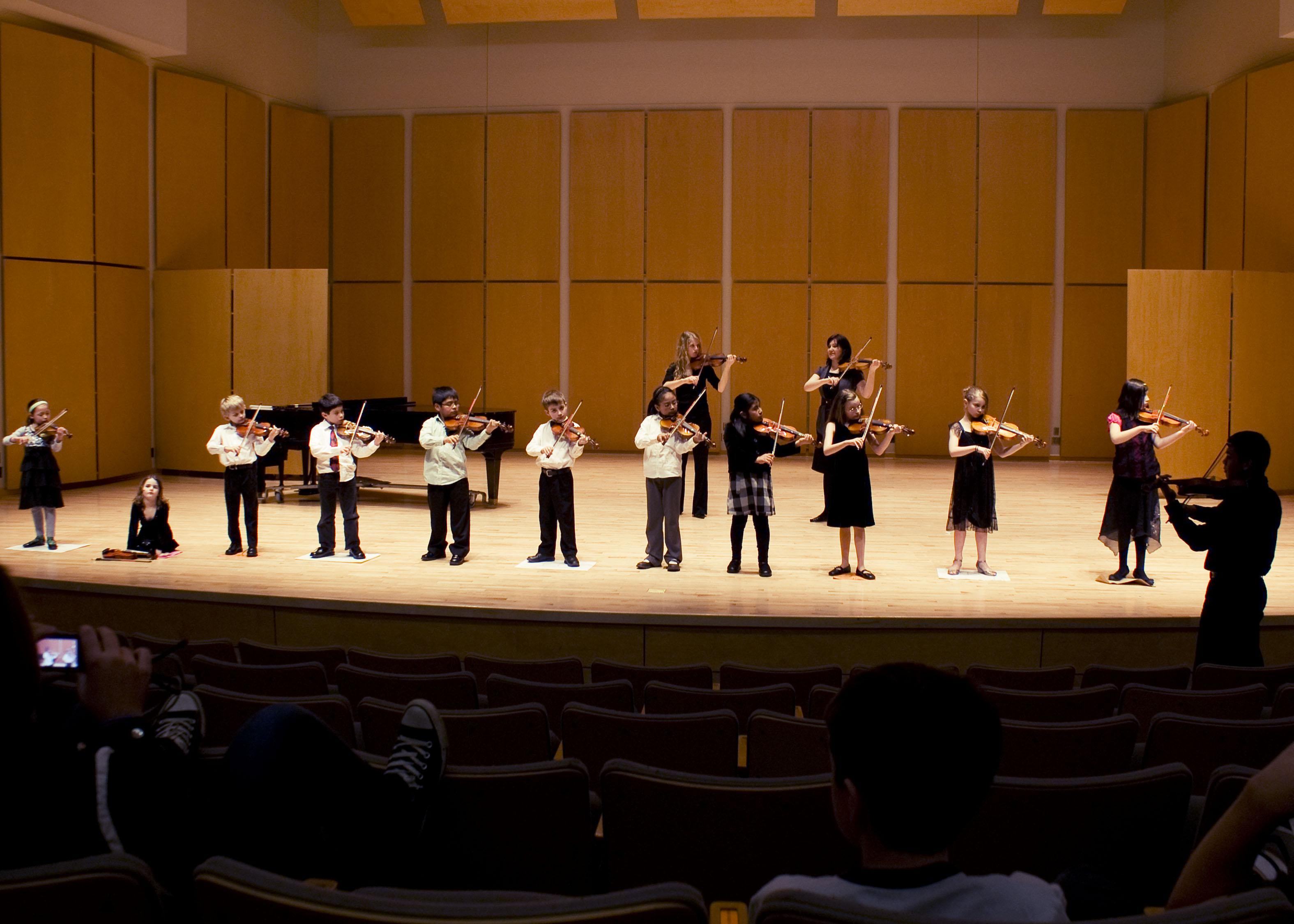 Forest Grove, Oregon
Forest Grove, Oregon
This program began in 2011 and is ongoing.
String Project is a national music education program in which Pacific University string students learn how to instruct young string players in grades 2-12. Student teachers are supervised by Bryce Seliger, Master Teacher & Director of Music Education. Pacific University is proud to be Oregon's first String Project endorsed by the National String Project Consortium.
The program is comprised of 30 school-age students, who are instructed in violin, viola, cello, and bass, by 5 undergraduate Teachers-in-Preparation. The undergraduate students also attend weekly pedagogy classes under the instruction of Bryce Seliger and are observed and critiqued as they teach String Project classes. Seliger also educates parents in helping their children with practicing. The program represents students of all backgrounds, and makes scholarships available to those in need.
The benefits of the program are threefold:
-
University students gain long-term experience in teaching, while being compensated for their work;
-
The 2nd-12th grade students learn how to play string instruments in a high quality educational setting at an affordable price;
-
String instrument education, the importance of which is often underestimated in public school systems, is re-invigorated with ample support.
By Nikolasa Tejero, Assistant Professor of Clarinet
University of Tennessee at Chatanooga
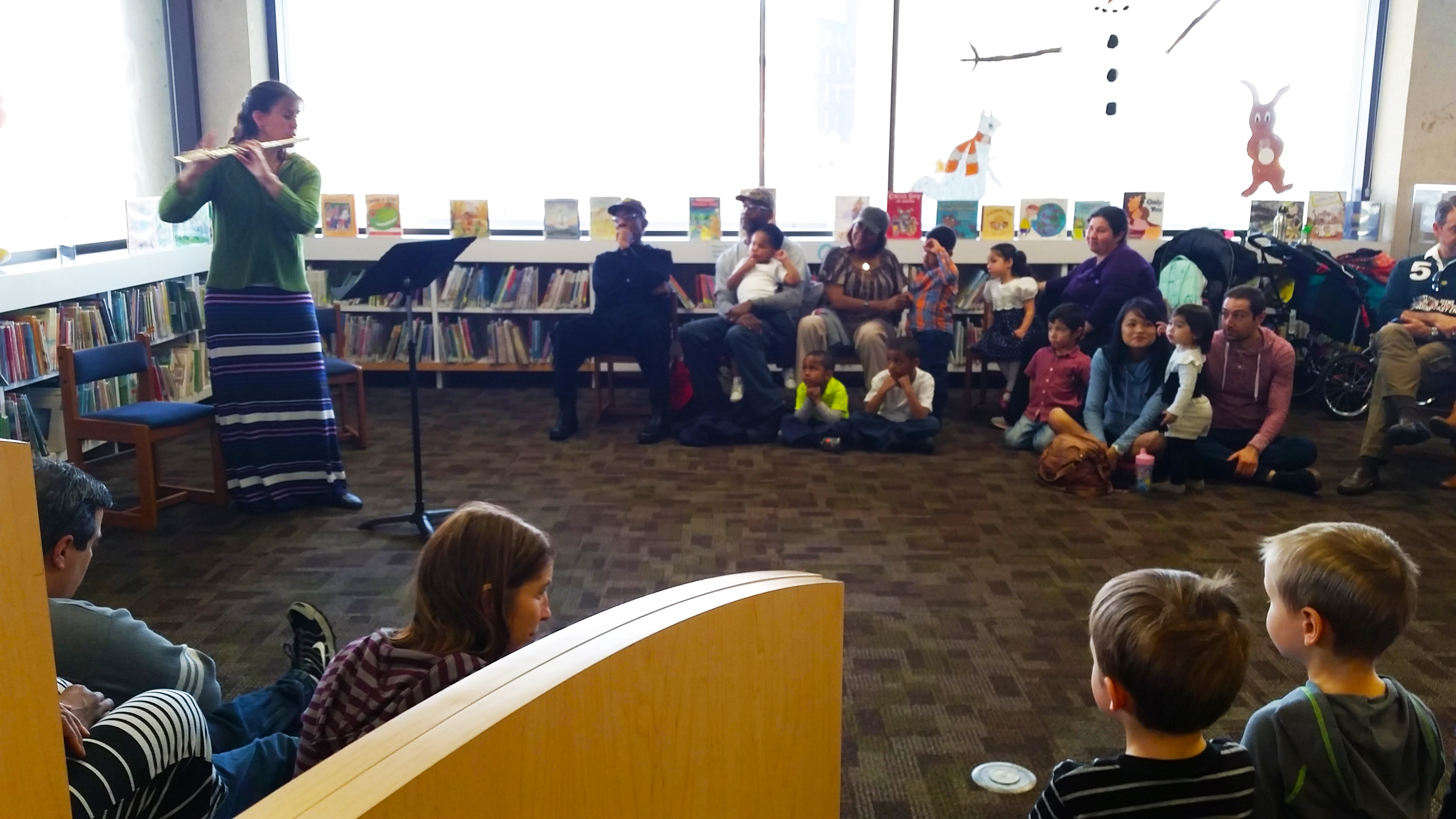 The University of Tennessee at Chattanooga's Department of Music partnered with the
Chattanooga Public Library's Children's Department to create Symphonic Tales, a music and literacy series for young children. With financial support from the The CMS Fund, series directors Dr. Nikolasa Tejero (UTC music faculty) and Olga Russell (Chattanooga
Public Library staff) collaborated to create children's programs exploring art music through the lens of literary themes.
The University of Tennessee at Chattanooga's Department of Music partnered with the
Chattanooga Public Library's Children's Department to create Symphonic Tales, a music and literacy series for young children. With financial support from the The CMS Fund, series directors Dr. Nikolasa Tejero (UTC music faculty) and Olga Russell (Chattanooga
Public Library staff) collaborated to create children's programs exploring art music through the lens of literary themes.
The 2015-16 Symphonic Tales series consisted of nine programs aimed at young children (ranging from nine months to eight years of age), which were offered on a once-a-month basis, from September to May. These programs combined live performances of art
music—along with folk and popular selections—to heighten the narrative and dramatic elements of the featured stories. Along with the music and tales, each event featured varied physical and creative activities, from dancing, pantomiming, and play-acting,
to arts-and-crafts projects, all carefully chosen to enhance each event's particular theme.
The combinations of interdisciplinary activities in each program of the Symphonic Tales series have positively impacted the Chattanooga Public Library's
young patrons in a number of ways, including
• a heightening of general interest in and curiosity about reading and other literacy-related activities;
• improved disposition toward developing early literacy skills;
• enhanced listening skills and attention spans;
• increased sensitivity
and response to musical stimuli;
• acquired familiarity with children's literature and music; and
• development of gross and fine motor skills, as well as physical coordination.
The Symphonic Tales staff kindly thanks The CMS Fund for their financial support of the 2015-16 season.
Jonathan Hehn (The American Guild of Organists, Tallahassee Chapter)
2012 Community Engagement Seed Grant
Assisted by: The Florida State University College of Music, Florida State University Department of Religion, Florida American Choral Directors Association, and the Church Music Institute, Inc.
Tallahassee, Florida
January 31 - February 2, 2013
Church Musicians and Pastors from across the United States, representing all major Christian denominational traditions, as well as Reform Judaism, were in attendance.
The goal of the Tallahassee Church Music Conference is to promote mutual understanding in the practice and theology of music in the church.
The Tallahassee Church Music Conference is a biennial, ecumenical event held in Tallahassee in odd numbered years. It brings musicians, clergy, and congregants together from across the United States for seminars, discussion forums, and masterclasses devoted to church music. Concerts and worship services also provide the public with a broad and representative spectrum of music and worship. The Conference is sponsored by several different partnering organizations. These include the Dallas-based Church Music Institute, Inc., the Florida State University College of Music, the Florida State University Department of Religion, the Florida American Choral Directors Association, and the Tallahassee Chapter of the American Guild of Organists.
Previous conferences have brought over 1500 conferees, concert attendees, and worshipers together for three days of events. Former faculty members include: Marva Dawn, André Thomas, John Ferguson, Patrick Evans, Michael Corzine, and many others.
Noah Getz, Musician-In-Residence, American University
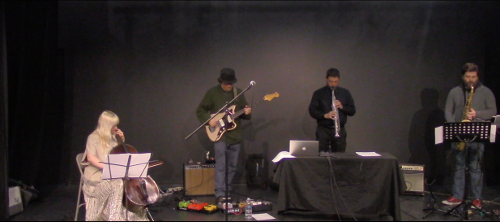 The East of the River Concert Series was created to help provide meaningful cultural and musical events
in the poorest areas of Washington, DC, which are located east of the Anacostia River. For decades there has been a physical and psychological boundary to the mixture of cultural and economic ideas from these areas and the city as a whole. Music can
be an amazing catalyst for creating a dialogue about these challenges and bringing together people in a meaningful way. Anacostia is a historical area in the District that is well positioned to help artists find a new home for their work as well as draw
audiences from poor and underserved communities to accessible performances in their own neighborhood.
The East of the River Concert Series was created to help provide meaningful cultural and musical events
in the poorest areas of Washington, DC, which are located east of the Anacostia River. For decades there has been a physical and psychological boundary to the mixture of cultural and economic ideas from these areas and the city as a whole. Music can
be an amazing catalyst for creating a dialogue about these challenges and bringing together people in a meaningful way. Anacostia is a historical area in the District that is well positioned to help artists find a new home for their work as well as draw
audiences from poor and underserved communities to accessible performances in their own neighborhood.
The CMS Fund grant allowed our non-profit Pictures on Silence to rent the hall at the Anacostia Arts Center and present the first performance
in our concert series. This took place on Saturday, March 19, 2016. This performance presented the Electric Jazz Improv Collective, an exciting new musical collaboration between four local musicians consisting of jazz saxophone, classical saxophone with
real-time computer processing and the guitar and amplified cello duo Anthony and Janel. This collective focuses on improvisation while exploring a variety of musical styles which underscores the mixture of different backgrounds and viewpoints that makes
the East of the River series so compelling. Videos from the concert will be used to seek funding to present a season of performances.
John Mortensen, Cedarville University, Cedarville, Ohio
In 2011 I created a college course in traditional Irish music at Cedarville University. I had been studying and performing in this style for some time and the more I performed the music, the more young musicians wanted to learn about it. In particular, there was strong interest among the music majors within my own department.
Traditional Irish music is intensely social. It is meant to be the centerpiece of a gathering of friends. It is not a performance in the classical sense but is, instead, a session of Irish music in a social gathering. While music is at the center, it does not preclude conversation around the edges. I believe that these two factors — functioning as a social gathering and welcoming the non-player into the middle of the action — give the traditional Irish music session a unique power to engage new audiences for music and to strengthen bonds of community.
The 2015 CMS Fund Seed Grant Award created an opportunity for my students to participate in a community engagement experience. I planned to use grant funds to organize a public session in an area coffee shop and have the students invite the public, play for them, and welcome them into the casual interaction that is characteristic of Irish sessions.
Toward the end of the semester, however, our local opera house sponsored a traditional Irish music concert and invited my students to perform a pre-show. We decided to use this performance opportunity as our community engagement project because the opera
house audiences draw from the farmers and workers of our rural community. The students memorized and performed six jigs and three reels in a contiguous set. None of the students had performed in front of a large audience.
This was a highly successful
event. The students played very well and were very well received. The performers reported that the prospect of playing in the opera house was daunting at first, but they quickly grew to enjoy the experience. They especially enjoyed having the opportunity
to learn about traditional Irish music and to share it with the community.
by Teresa Marrin Nakra and Kim Pearson, College of New Jersey
The Trenton Makes Music project represents a comprehensive collaboration between faculty and students at The College of New Jersey (TCNJ1), the Trenton School District, scholars, performing artists, and members of the local musical community. The CMS
Fund Community Engagement Seed Grant Award provided an important anchor toward a subsequent Major Grant award from the New Jersey Council for the Humanities in January 2016. Combined with several other funding sources from within our institution, we
are now collaborating with the Trenton Central High School orchestra director to select and arrange repertoire by local R&B, Funk, and Hip-hop groups for his students to perform in a public program this fall.
Research has shown that
the artistic heritage of a community can be a great catalyst for cultural and economic development – amply demonstrated in other New Jersey cities such as Asbury Park, Red Bank and Newark. Indeed, Trenton itself has invested substantially in arts and
heritage tourism over the years, sometimes with great success.
Trenton has been a city with a soundtrack heard around the world. Composers and performers from Trenton have produced diverse works, ranging from George Antheil’s Ballet Mechanique
to Labelle’s Lady Marmalade to the jazz of pianist Orrin Evans, saxophonist Richie Cole, Kool and the Gang trombonist Clifford Adams, neogriot hip-hop group Poor Righteous Teachers, and the post-modern precocity of Odd Future. With limited human and
financial resources, the Trenton Historical Society has made a sustained effort to capture the memories and locations central to the city’s cultural history, but greater community involvement is needed.
The overarching purpose of our project
is to apply the “Trenton Makes” motto to contextualize musical culture as an important driver of cultural memory, identity, and economic development. We will contribute to the base of scholarly and popular knowledge about the role of music production
and performance in Trenton’s evolution from colonial times to the present. In addition to supporting the efforts of the Trenton Historical Society, our project engages current Trentons tudent musicians in musical activities with experts who share the
same birthplace and hometown.
Through the internet, the Trenton Makes Music project augments the resources available to music scholars, historians, K-16 educators, and those concerned with developing Trenton as a site of heritage tourism.
The public events and the interactive website and its social media extensions provide an ongoing forum for conversation and exploration.
From Romanticism to Mestizo Modernism: Mexican Piano Music
American Women Composers
Max Lifchitz (University of Albany, SUNY), piano
Clarion Music Center, San Francisco, California, November 5, 2004
The University of Utah, Salt Lake City, Utah, November 16, 2007
In the first presentation on November 5, 2004, pianist Max Lifchitz performed and discussed music by Mexican composers for an audience of local community members (Chinatown, San Francisco).
In the second presentation on November 16, 2007, Mr. Lifchitz performed and discussed music by American women composers for a university class.
The goal of this project was to introduce audiences to lesser known composers and musical styles not normally encountered in traditional recitals. The events followed the format of lecture-recitals. Mr. Lifchitz introduced the topic for each program and spoke about each piece prior to its performance. At the end of the programs, audience members asked questions and commented on relevant aspects of the performances. Mr. Lifchitz enjoyed interacting with diverse audiences from different parts of the country, and found the experience beneficial to his own artistic development. The two performances gave audiences the opportunity to listen to and discuss music that is often not included in the traditional piano repertoire. Audience reaction was positive, and many expressed interest in learning more about the composers.


